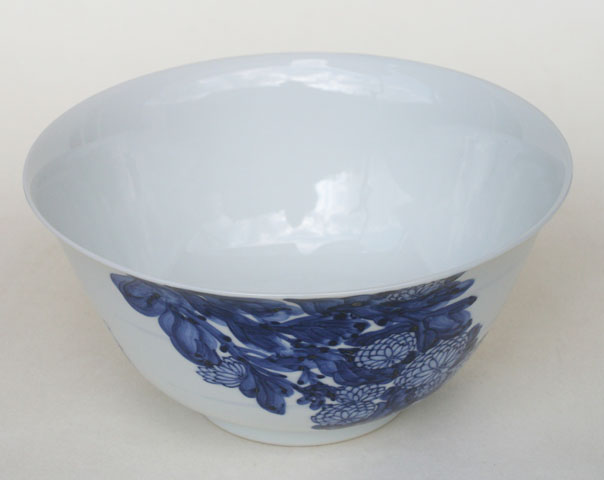Nanga
Kashibachi,, bowl for sweets - Chrysanthemums and butterfly.Signed: Hachijûhachiô Tessai, Karaku Tôsai
Seals:
Technique: Kyoyaki sometsuke (Seikaji) - Translucent blue and white porcelain with a hand painted cobalt blue underglaze decoration. Ø 20,3 x 9,8
Date: 1924
Condition: fine
Tessai was born in Kyoto into a family selling robes and accessories for the Buddhist clergy. As a result of a childhood illness he became partly deaf. It was therefore considered improbable that he would ever become a successful shopkeeper. Instead he went to study the Japanese classics in order to become a Shinto priest. He also did Chinese studies, specializing in the teachings of the neo-confucianist Wang Yang-Ming. Later he would study Buddhism, literature and Shingaku, a semi-religious system for self-cultivation.
As a youth Tessai met Ōtagaki Rengetsu (1791-1875) and became her special protégé. She taught him waka and encouraged his artistic inclinations. Tessai was mainly self-taught, indepently studying Nanga painting and learning from friends. He was, however, strongly influenced by Shinten’ô.
In the final years of the Tokugawa era Tessai was involved in the pro-imperialist movement. For fear of being arrested he left Kyoto in 1861 and travelled to Nagasaki. It was the first of many trips; Tessai became and avid traveller. In 1882 he settled in Kyoto where he spent the rest of his life. Although he worked as a priest at several Shinto shrines, he saw painting as his chief occupation. Between 1894 and 1904 he was a teacher at the Kyoto Prefectural Art School and he was a regular contributor to exhibitions of the Nanga Society. In 1917 he was appointed Artist to the Imperial Household and towards the end of his life he received an honorary court-rank. Tessai is often seen as the last great exponent of the Nanga school.
Reference:
Kanazawa
Kato 1998
Roberts p. 181
Araki pp. 2754-2755
Aburai pp. 266-267
Morioka & Berry ‘99 pp. 116-121 (# 20-21)
Morioka & Berry ‘08 p. 305-06 (# 11, 46)
Tôsai I started the Sawamura kiln at Gojô near Kiyomizudera around 1919. In 1941 after his death the second generation took over and in 1995 the 3rd generation.
Price: ON REQUEST

